Integration of SETS (Social–Ecological–Technological Systems) Framework and Flood Resilience Cycle for Smart Flood Risk Management
Abstract
1. Introduction
2. Material and Methods
2.1. SETS Framework towards Flood Management and Resilience
2.2. Significance of Water Smart Cities
2.3. Research Methods and Framework
3. Results
3.1. SETS in Local Government Documents
3.2. Mapping SETS and FRC in Current Flood Management Strategies
3.3. Water Smart City Approach for Flood Resilience in Samarinda and Balikpapan City
- A.
- Water Smart City—Ecological Domains
- B.
- Water Smart City—Technological Domain
- C.
- Water Smart City—Social Domain
4. Discussions
5. Conclusions
Author Contributions
Funding
Data Availability Statement
Acknowledgments
Conflicts of Interest
Appendix A. List of Local Government Documents
| No. | Document Name | Strategies Extracted and Strategy Code |
| Balikpapan | ||
| 1 | Government Regulation Number 13 of 2017 concerning National Spatial Planning | Zero Delta Q policy is suggested to be one of the benchmarks of successful implementations of the regional drainage system (T1) |
| 2 | Regional Action Plan for Reducing Greenhouse Gas Emissions in the East Kalimantan Province | Development of irrigation network, paddy field network (E3), and flood control facilities and infrastructure (E2) |
| 3 | Regional Regulation Of the East Kalimantan Province Number 2 Year 2013 Concerning Regional Disaster Management | Conducting disaster risk analysis, monitoring and evaluation (T4), organizing disaster management education and training in accordance with its mandate and authority, based on the guidelines set by the Regional Disaster Management Agency (S4), implementing preparedness and early warning activities (S4), implementing disaster management at the post-disaster phase (rehabilitation and reconstruction) (T1,T2) |
| 4 | Spatial Plan of Balikpapan (RTRW) | More than a dozen flood-prone areas in Balikpapan have been identified for 13 Bendali (Flood Control Dams). However, only three city–government-owned dams have been constructed (Dam 3, Dam 4, and Wonorejo Dam) (T1) |
| 5 | Flood Management Study Documents | Provision of detention ponds with 2.5 m in depth dimension (T1). The scenario of providing detention ponds with the depth dimension of 3 m (T1) The scenario for maintaining the green area in the design year, in 2032 at least 20% and with the direction of providing a detention pond dimension of 2.5 m, (E1) maintain green cover area in planned year (2032) with minimum of 20% and with the direction of the dimensions of providing a detention pond of 3 m (E1) |
| 6 | Balikpapan Drainage Master Plan | Development of an environmentally friendly drainage system (E3); determining priorities for handling, development, and improvement in strategic areas that are vulnerabile to inundation (S2); creating a coordination mechanism, assigning the roles and responsibilities of the government, private sector, and community in handling drainage; strengthening institutional capacity, and increasing human resources for drainage management. (S3) |
| 7 | Balikpapan Regulation Number 5 of 2013 concerning Provision of Infrastructure, Facilities, and Utilities in Residential Areas | Balikpapan sets 4% of the site area for the provision of green open space (E1) |
| 8 | Mayor Regulation Number 22 year 2021 concerning Detailed Spatial Planning and Zoning Regulations of Balikpapan for 2021–2041 | Structuring the area around the reservoir (T1), reforestation around the reservoirs (E1), and revitalisation of urban slum areas (E1) |
| 9 | Regional Regulation No 2 year 2018 Concerning Regional Disaster Management Implementation | Determining areas that are vulnerable to natural disasters (floods) to be away from human settlements (S2), installation and testing of early warning system, preparation of evacuation locations (S1), develop Vulnerability Map including floods (T4) |
| Samarinda | ||
| 1 | Government Regulation Number 13 of 2017 concerning National Spatial Planning | Zero Delta Q policy is suggested to be one of the benchmarks of successful implementations of the regional drainage system (T1) |
| 2 | Regional Action Plan for Reducing Greenhouse Gas Emissions in the East Kalimantan Province | Development of irrigation network, paddy field network (E3),and flood control facilities and infrastructure (E2) |
| 3 | Regional Regulation Of the East Kalimantan Province Number 2 Year 2013 Concerning Regional Disaster Management | Conducting disaster risk analysis, monitoring and evaluation (T4); organizing disaster management education and training in accordance withits mandate and authority, based on the guidelines set by the Regional Disaster Management Agency (S4); implementing preparedness and early warning activities (S4); implementing disaster management at the post-disaster phase (rehabilitation and reconstruction) (T1,T2) |
| 4 | Regional Regulation Of The City Of Samarinda Number 2 Of 2014 Concerning Spatial Plan For The City Of Samarinda 2014–2034 | Implementing a flood control system by building retention and detention ponds to accommodate overflowing water (T2); providing a flood evacuation route (S4); mapping flood-vulnerable areas (T4); developing a program to improve the drainage system in flood-vulnerable areas with a tiered and integrated system (S2) |
| 5 | Regional Regulation Of The City Of Samarinda Number 10 Year 2017 Concerning Implementation Of Disaster Management | Establishing a Disaster Risk Reduction Forum (S3); organizing education and training activities at formal, non-formal and informal levels aimed to increase awareness, concern, capability, as well as Community Preparedness in dealing with disasters (S4); implementation and enforcement of building construction provisions (T1); development of spatial planning based on Disaster Risk analysis (T1) |
| 6 | Regulation Of The Mayor Of Samarinda Number 8 Year 2018 Concerning The Samarinda Smart City Masterplan | Organizing the banks of the Karang Mumus River to support flood control and the Waterfront City concept (T3) and Optimizing land management to cope flooding (S2) |
Appendix B. Mapping SETS and Flood Resilience in Samarinda and Balikpapan
| Prevention | Preparation | Response | Recovery | |
| Balikpapan | Zero Delta Q policy (T1) | Flood control facilities and infrastructure (E2) | Conducting disaster risk analysis, monitoring and evaluation (T4) | Implementing disaster management at the post-disaster stage (rehabilitation and reconstruction) (T1,T2) |
| Development of irrigation network, paddy field network (E3) | Implementing of preparedness and early warning activities (S4) | Create a coordination mechanism; determine the roles and responsibilities of the government, the private sector, and the community in handling drainage; strengthen institutional capacity; and increase human resources for drainage management (S3) | ||
| Organizing disaster management education and training (S4) | Organizing disaster management education and training (S4) | |||
| More than a dozen flood-vulnerability areas in Balikpapan have been designated for 13 Bendali (Flood Control Dams) (T1) | Determine priorities for flood handling, development, and improvement in strategic areas vulnerability to inundation (S2) | |||
| Provision of detention ponds with the direction of the depth dimension of the detention pond being 2.5 m (T1) | Installation and testing of early warning system; preparation of evacuation locations (S1) | |||
| The scenario of providing detention ponds with the direction of the depth dimension of the detention pond is 3 m (T1) | ||||
| The scenario for maintaining the green cover area in the design year, in 2032 at least 20% and with the direction of providing a detention pond dimension of 2.5 m (E1) | ||||
| Maintain green cover area in plan year (2032) with minimum of 20% and with the direction of the dimensions of providing a detention pond of 3 m (E1) | ||||
| Development of an environmentally friendly drainage system (E3) | ||||
| Balikpapan sets 4% of the site area for the provision of green open space (E1) | ||||
| Structuring the area around the reservoir (T1) | ||||
| Reforestation around reservoirs (E1) | ||||
| Revitalization of urban slum areas (E1) | ||||
| Determine areas vulnerability to natural disasters (floods) far from settlements (S2) | ||||
| Develop Vulnerability Map including Flood (T4) | ||||
| Samarinda | Zero Delta Q policy (T1) | Flood control facilities and infrastructure (E2) | Conducting disaster risk analysis, monitoring and evaluation (T4) | Implementing disaster management at the post-disaster stage (rehabilitation and reconstruction) (T1,T2) |
| Development of irrigation network, paddy field network (E3) | Organizing disaster management education and training (S4) | Implementing preparedness and early warning activities (S4) | ||
| Organizing disaster management education and training (S4) | Implementing of preparedness and early warning activities (S4) | Providing a flood evacuation route (S4) | ||
| Implementing a flood control system by built retention ponds and detention ponds to accommodate overflowing water (T2) | Organizing education and training activities at formal, non-formal, and informal levels aimed at increasing awareness, concern, capability, and Community Preparedness in dealing with disasters (S4) | Establishing a Disaster Risk Reduction Forum (S3) | ||
| Mapping flood-vulnerability areas (T4) | ||||
| Develop a program to improve the drainage system in flood-vulnerability areas with a tiered and integrated system (S2) | ||||
| Implementation and enforcement of building construction provisions (T1) | ||||
| Develop spatial planning based on Disaster Risk analysis (T1) | ||||
| Organizing the banks of the Karang Mumus River to support flood control and the Waterfront City concept (T3) | ||||
| Optimization of land management to cope flooding (S2) |
References
- Ruffer, D.G. Effect of Flooding on a Population of Mice. J. Mammal. 1961, 42, 494–502. [Google Scholar] [CrossRef]
- Chang, L.F.; Huang, S.L. Assessing urban flooding vulnerability with an emergy approach. Landsc. Urban Plan. 2015, 143, 11–24. [Google Scholar] [CrossRef]
- Sholihah, Q.; Kuncoro, W.; Wahyuni, S.; Puni Suwandi, S.; Dwi Feditasari, E. The analysis of the causes of flood disasters and their impacts in the perspective of environmental law. IOP Conf. Ser. Earth Environ. Sci. 2020, 437, 012056. [Google Scholar] [CrossRef]
- Ahilan, S.; Guan, M.; Sleigh, A.; Wright, N.; Chang, H. The influence of floodplain restoration on flow and sediment dynamics in an urban river. J. Flood Risk Manag. 2018, 11, S986–S1001. [Google Scholar] [CrossRef]
- United Nations Office for Disaster Risk Reduction. Sendai Framework for Disaster Risk Reduction 2015–2030; The United Nations Office for Disaster Risk Reduction: Geneva, Switzerland, 2015. [Google Scholar]
- United Nations Office for Disaster Risk Reduction; Centre for Research on the Epidemiology of Disasters. The Human Cost of Weather-Related Disasters 1995–2015; Report; The UN Office for Disaster Risk Reduction: Geneva, Switzerland, 2015. [Google Scholar]
- Konrad, C.P. Effects of Urban Development on Floods; USGS Fact Sheet FS-076-03; USGS: Reston, VA, USA, 2003.
- Hapsari, R.I.; Zenurianto, M. View of Flood Disaster Management in Indonesia and the Key Solutions. Am. J. Eng. Res. 2016, 5, 140–151. [Google Scholar]
- Dwirahmadi, F.; Rutherford, S.; Phung, D.; Chu, C. Understanding the operational concept of a flood-resilient urban community in Jakarta, Indonesia, from the perspectives of disaster risk reduction, climate change adaptation and development agencies. Int. J. Environ. Res. Public Health 2019, 16, 3993. [Google Scholar]
- Tarigan, A.K.M.; Samsura, D.A.A.; Sagala, S.; Wimbardana, R. Balikpapan: Urban planning and development in anticipation of the post-oil industry era. Cities 2017, 60, 246–259. [Google Scholar] [CrossRef]
- Wardhana, I.G. Enhancing Resilience in Balikpapan as Buffer Zone for the New Capital City of Indonesia. Master’s Thesis, University of Groningen, Groningen, The Netherlands, 2021. [Google Scholar]
- Aerts, J.C.J.H.; Botzen, W.J.W.; Emanuel, K.; Lin, N.; De Moel, H.; Michel-Kerjan, E.O. Climate adaptation: Evaluating flood resilience strategies for coastal megacities. Science 2014, 344, 473–475. [Google Scholar] [CrossRef]
- Singh, P.; Amekudzi-Kennedy, A.; Woodall, B.; Joshi, S. Lessons from case studies of flood resilience: Institutions and built systems. Transp. Res. Interdiscip. Perspect. 2021, 9, 100297. [Google Scholar] [CrossRef]
- Moloney, S.; Fünfgeld, H. Emergent processes of adaptive capacity building: Local government climate change alliances and networks in Melbourne. Urban Clim. 2015, 14, 30–40. [Google Scholar] [CrossRef]
- Chmutina, K.; Lizarralde, G.; Dainty, A.; Bosher, L. Unpacking resilience policy discourse. Cities 2016, 58, 70–79. [Google Scholar] [CrossRef]
- Auliagisni, W.; Wilkinson, S.; Elkharboutly, M. Using community-based flood maps to explain flood hazards in Northland. N. Z. Prog. Disaster Sci. 2022, 14, 100229. [Google Scholar] [CrossRef]
- Maimunah, S.; Rosli, N.S.; Rafanoharana, S.; Sari, K.R.; Higashi, O. Strengthening Community to Prevent Flood Using Participatory Approach: A case of Semarang City, Indonesia. J. Int. Dev. Coop. 2011, 18, 19–28. [Google Scholar]
- Grimm, N.B.; Pickett, S.T.A.; Hale, R.L.; Cadenasso, M.L. Does the ecological concept of disturbance have utility in urban social–ecological–technological systems? Ecosyst. Health Sustain. 2017, 3, e01255. [Google Scholar] [CrossRef]
- Markolf, S.A.; Chester, M.V.; Eisenberg, D.A.; Iwaniec, D.M.; Davidson, C.I.; Zimmerman, R.; Miller, T.R.; Ruddell, B.L.; Chang, H. Interdependent Infrastructure as Linked Social, Ecological, and Technological Systems (SETSs) to Address Lock-in and Enhance Resilience. Earth’s Future 2018, 6, 1638–1659. [Google Scholar] [CrossRef]
- van Hattum, T.; Blauw, M.; Bergen Jensen, M.; de Bruin, K. Towards Water Smart Cities. Wageningen Environ. Res. Rapp. 2016, 60, 2787. Available online: https://edepot.wur.nl/407327 (accessed on 12 January 2022).
- Hamstead, Z.; Iwaniec, D.; McPhearson, T.; Berbés-Blázquez, M.; Cook, E.M.; Muñoz-Erickson, T.A. Resilient Urban Futures; Springer: Berlin/Heidelberg, Germany, 2021. [Google Scholar]
- Cheng, C.; Yang, Y.C.E.; Ryan, R.; Yu, Q.; Brabec, E. Assessing climate change-induced flooding mitigation for adaptation in Boston’s Charles River watershed. USA. Landsc. Urban Plan. 2017, 167, 25–36. [Google Scholar] [CrossRef]
- Chang, H.; Pallathadka, A.; Sauer, J.; Grimm, N.B.; Herreros-Cantis, P. Assessment of urban flood vulnerability using the social-ecological-technological systems framework in six US cities. Sustain. Cities Soc. 2021, 68, 102786. [Google Scholar] [CrossRef]
- Gade, D.S. Reinventing Smart Water Management System through ICT and IoT Driven Solution for Smart Cities. Int. J. Appl. Eng. Manag. Lett. 2021, 5, 132–151. [Google Scholar] [CrossRef]
- Keshavarzi, G.; Yildirim, Y.; Arefi, M. Does scale matter? An overview of the ‘smart cities’ literature. Sustain. Cities Soc. 2021, 74, 103151. [Google Scholar] [CrossRef]
- Kitchin, R. The real-time city? Big data and smart urbanism. Geo. J. 2014, 79, 1–14. [Google Scholar] [CrossRef]
- Oberascher, M.; Rauch, W.; Sitzenfrei, R. Towards a smart water city: A comprehensive review of applications. data requirements, and communication technologies for integrated management. Sustain. Cities Soc. 2022, 76, 103442. [Google Scholar] [CrossRef]
- Sukhwani, V.; Shaw, R.; Deshkar, S.; Mitra, B.K.; Yan, W. Role of smart cities in optimizing water-energy-food nexus: Opportunities in Nagpur, India. Smart Cities 2020, 3, 1266–1292. [Google Scholar] [CrossRef]
- Araos, M.; Berrang-Ford, L.; Ford, J.D.; Austin, S.E.; Biesbroek, R.; Lesnikowski, A. Climate change adaptation planning in large cities: A systematic global assessment. Environ. Sci. Policy 2016, 66, 375–382. [Google Scholar] [CrossRef]
- Syalianda, S.I.; Kusumastuti, R.D. Implementation of smart city concept: A case of Jakarta Smart City, Indonesia. IOP Conf. Ser. Earth Environ. Sci. 2021, 716, 012128. [Google Scholar] [CrossRef]
- Muñoz-Erickson, T.A.; Miller, C.A.; Miller, T.R. How cities think: Knowledge co-production for urban sustainability and resilience. Forests 2017, 8, 203. [Google Scholar] [CrossRef]
- Folke, C.; Hahn, T.; Olsson, P.; Norberg, J. Adaptive governance of social-ecological systems. Annu. Rev. Environ. Resour. 2005, 30, 441–473. [Google Scholar] [CrossRef]
- Carmin, J.; Anguelovski, I.; Roberts, D. Urban Climate Adaptation in the Global South: Planning in an Emerging Policy Domain. J. Plan. Educ. Res. 2012, 32, 18–32. [Google Scholar] [CrossRef]
- Fisher, L. Disaster responses: More than 70 ways to show resilience. Nature 2015, 518, 35. [Google Scholar] [CrossRef]
- Cutter, S.L.; Ahearn, J.A.; Amadei, B.; Crawford, P.; Eide, E.A.; Galloway, G.E.; Goodchild, M.F.; Kunreuther, H.C.; Li-Vollmer, M.; Schoch-Spana, M.; et al. Disaster resilience: A national imperative. Environment 2013, 55, 25–29. [Google Scholar] [CrossRef]
- Basabe, P. Hyogo framework for action 2005–2015. In Encyclopedia of Earth Sciences Series; Bobrowsky, P.T., Ed.; Springer: Dordrecht, The Netherlands, 2013; pp. 508–516. [Google Scholar]
- Cosco, T.D.; Kaushal, A.; Hardy, R.; Richards, M.; Kuh, D.; Stafford, M. Operationalising resilience in longitudinal studies: A systematic review of methodological approaches. J. Epidemiol. Community Health 2017, 71, 98–104. [Google Scholar] [CrossRef] [PubMed]
- Attolico, A.; Smaldone, R. The #weResilient strategy for downscaling local resilience and sustainable development: The Potenza province and municipalities of Potenza and Pignola case. Disaster Prev. Manag. Int. J. 2020, 29, 793–810. [Google Scholar]
- Kim, N.W.; Lee, J.Y.; Park, D.H.; Kim, T.W. Evaluation of future flood risk according to rcp scenarios using a regional flood frequency analysis for ungauged watersheds. Water 2019, 11, 992. [Google Scholar] [CrossRef]
- Herdiyanti, A.; Hapsari, P.S.; Susanto, T.D. Modelling the smart governance performance to support smart city program in Indonesia. Procedia Comput. Sci. 2019, 161, 367–377. [Google Scholar] [CrossRef]
- Adedeji, T.; Proverbs, D.; Xiao, H.; Cobbing, P.; Oladokun, V. Making Birmingham a flood resilient city: Challenges and opportunities. Water 2019, 11, 1699. [Google Scholar] [CrossRef]
- Yazdani, M.; Mojtahedi, M.; Loosemore, M.; Sanderson, D.; Dixit, V. An integrated decision model for managing hospital evacuation in response to an extreme flood event: A case study of the Hawkesbury-Nepean River. Saf. Sci. 2022, 155, 105867. [Google Scholar] [CrossRef]
- Heinzlef, C.; Robert, B.; Hémond, Y.; Serre, D. Operating urban resilience strategies to face climate change and associated risks: Some advances from theory to application in Canada and France. Cities 2020, 104, 102762. [Google Scholar] [CrossRef]
- Kitchin, R. Making sense of smart cities: Addressing present shortcomings. Cambridge J. Reg. Econ. Soc. 2015, 8, 131–136. [Google Scholar] [CrossRef]
- Yang, C.; Daigger, G.T.; Belia, E.; Kerkez, B. Extracting useful signals from flawed sensor data: Developing hybrid data-driven approaches with physical factors. Water Res. 2020, 185, 116282. [Google Scholar] [CrossRef]
- Newhart, K.B.; Holloway, R.W.; Hering, A.S.; Cath, T.Y. Data-driven performance analyses of wastewater treatment plants: A review. Water Res. 2019, 157, 498–513. [Google Scholar] [CrossRef] [PubMed]
- Mollerup, A.L.; Mikkelsen, P.S.; Thornberg, D.; Sin, G. Controlling sewer systems—A critical review based on systems in three EU cities. Urban Water J. 2017, 14, 435–442. [Google Scholar] [CrossRef]
- Yuan, Z.; Olsson, G.; Cardell-Oliver, R.; van Schagen, K.; Marchi, A.; Deletic, A.; Urich, C.; Rauch, W.; Liu, Y.; Jiang, G. Sweating the assets—The role of instrumentation, control and automation in urban water systems. Water Res. 2019, 155, 381–402. [Google Scholar] [CrossRef] [PubMed]
- Creaco, E.; Campisano, A.; Fontana, N.; Marini, G.; Page, P.R.; Walski, T. Real time control of water distribution networks: A state-of-the-art review. Water Res. 2019, 161, 517–530. [Google Scholar] [CrossRef]
- Wasko, C.; Westra, S.; Nathan, R.; Orr, H.G.; Villarini, G.; Herrera, R.V.; Fowler, H.J. Incorporating climate change in flood estimation guidance. Philos. Trans. R. Soc. A Math. Phys. Eng. Sci. 2021, 379, 20190548. [Google Scholar] [CrossRef]
- Ramos, H.M.; Carravetta, A.; McNabola, A.; Adeyeye, K. Environmental hydraulics research. Water 2020, 12, 2749. [Google Scholar] [CrossRef]
- Sinha, K.; Srivastava, D.K.; Bhatnagar, R. Water Quality Management through Data Driven Intelligence System in Barmer Region, Rajasthan. Procedia Comput. Sci. 2018, 132, 314–322. [Google Scholar] [CrossRef]
- Garau, C.; Pavan, V.M. Evaluating urban quality: Indicators and assessment tools for smart sustainable cities. Sustainability 2018, 10, 575. [Google Scholar] [CrossRef]
- Ler, L.G. Flood Resilience and Smart Water Management: Implementation Strategies for Smart Cities. Doctoral Dissertation, Université Côte d’Azur, Nice, France, Université nationale d’Incheon, Incheon, Korea, October 2018. [Google Scholar]
- Ramos, H.M.; McNabola, A.; López-Jiménez, P.A.; Pérez-Sánchez, M. Smart Water Management towards Future Water. Water 2019, 12, 58. [Google Scholar] [CrossRef]
- Ewing, G.; Demir, I. An ethical decision-making framework with serious gaming: A smart water case study on flooding. J. Hydroinform. 2021, 23, 466–482. [Google Scholar] [CrossRef]
- Mullapudi, A.; Wong, B.P.; Kerkez, B. Emerging investigators series: Building a theory for smart stormwater systems. Environ. Sci. Water Res. Technol. 2017, 3, 66–77. [Google Scholar] [CrossRef]
- Babel, M.S.; Shinde, V.R.; Sharma, D.; Dang, N.M. Measuring water security: A vital step for climate change adaptation. Environ. Res. 2020, 185, 109400. [Google Scholar] [CrossRef] [PubMed]
- Yildirim, E.; Demir, I. An integrated web framework for HAZUS-MH flood loss estimation analysis. Nat. Hazards 2019, 99, 275–286. [Google Scholar] [CrossRef]
- Ariyaningsih; Erik, B.; Sukmara, B. Kriteria ketahanan kota berdasarkan jenis bencana prioritas di Kota Balikpapan. Reg. J. Pembang. Wil. dan Perenc. Partisipatif 2021, 16, 74–82. [Google Scholar] [CrossRef]
- Benny Sukmara, R.; Shyan Wu, R. Resources and Ecological Conservation Management in Samarinda, Indonesia: Recent Progress. In Proceedings of the 20th Cross-Strait Symposium on Environment, Chiayi, Taiwan, 16–22 June 2019. [Google Scholar] [CrossRef]
- Berbés-Blázquez, M.; Mitchell, C.L.; Burch, S.L.; Wandel, J. Understanding climate change and resilience: Assessing strengths and opportunities for adaptation in the Global South. Clim. Chang. 2017, 141, 227–241. [Google Scholar] [CrossRef]
- Brody, S.D.; Highfield, W.E.; Blessing, R.; Makino, T.; Shepard, C.C. Evaluating the effects of open space configurations in reducing flood damage along the Gulf of Mexico coast. Landsc. Urban Plan. 2017, 167, 225–231. [Google Scholar] [CrossRef]
- Russo, B.; Velasco, M.; Locatelli, L.; Sunyer, D.; Yubero, D.; Monjo, R.; Martínez-Gomariz, E.; Forero-Ortiz, E.; Sánchez-Muñoz, D.; Evans, B.; et al. Assessment of urban flood resilience in barcelona for current and future scenarios. The RESCCUE Project. Sustainability 2020, 12, 5638, Erratum in Sustainability 2020, 12, 9875. [Google Scholar] [CrossRef]
- Jhong, B.C.; Tachikawa, Y.; Tanaka, T.; Udmale, P.; Tung, C.P. A generalized framework for assessing flood risk and suitable strategies under various vulnerability and adaptation scenarios: A case study for residents of Kyoto City in Japan. Water 2020, 12, 2508. [Google Scholar] [CrossRef]
- Alexander, K.; Hettiarachchi, S.; Ou, Y.; Sharma, A. Can integrated green spaces and storage facilities absorb the increased risk of flooding due to climate change in developed urban environments? J. Hydrol. 2019, 579, 124201. [Google Scholar] [CrossRef]
- Ariyaningsih; Sukhwani, V.; Shaw, R. Vulnerability assessment of Balikpapan (Indonesia) for climate change-induced urban flooding. Int. J. Disaster Resil. Built Environ. 2022; ahead-of-print. [Google Scholar] [CrossRef]
- Pranoto, Y.; Sudibyo, A.; Rivelda, E.R. Experimental Study of Porous Paving Using Kalimantan Local Materials. In Proceedings of the 2nd Borobudur International Symposium on Science and Technology (BIS-STE 2020), online, 18 November 2020; Atlantis Press: Amsterdam, The Netherlands, 2021; Volume 203, pp. 144–147. [Google Scholar]
- Jones, C.S.; Davis, C.A.; Drake, C.W.; Schilling, K.E.; Debionne, S.H.; Gilles, D.W.; Demir, I.; Weber, L.J. Iowa Statewide Stream Nitrate Load Calculated Using In Situ Sensor Network. J. Am. Water Resour. Assoc. 2018, 54, 471–486. [Google Scholar] [CrossRef]
- Moon, Y.I.; Choi, J.H.; Kim, M.S.; Lee, J.H. Flood forecasting system of urban areas in SOUTH KOREA. Int. J. Saf. Secur. Eng. 2017, 7, 213–220. [Google Scholar] [CrossRef]
- Chang, H.; Yu, D.J.; Markolf, S.A.; Hong, C.Y.; Eom, S.; Song, W.; Bae, D. Understanding Urban Flood Resilience in the Anthropocene: A Social–Ecological–Technological Systems (SETS) Learning Framework. Ann. Am. Assoc. Geogr. 2020, 111, 837–857. [Google Scholar]
- Ghozali, A.; Ariyaningsih; Sukmara, R.B.; Aulia, B.U. A Comparative Study of Climate Change Mitigation and Adaptation on Flood Management between Ayutthaya City (Thailand) and Samarinda City (Indonesia). Procedia Soc. Behav. Sci. 2016, 227, 424–429. [Google Scholar] [CrossRef]
- De Angeli, S.; Malamud, B.D.; Rossi, L.; Taylor, F.E.; Trasforini, E.; Rudari, R. A multi-hazard framework for spatial-temporal impact analysis. Int. J. Disaster Risk Reduct. 2022, 73, 102829. [Google Scholar] [CrossRef]
- Setiawan, I.; Ilham, M.; Nawawi, M. Smart Governance Implementation in Balikpapan City. East Kalimantan. J. Borneo Kalimantan 2020, 6, 22–34. [Google Scholar] [CrossRef]
- Thanvisitthpon, N.; Shrestha, S.; Pal, I. Urban Flooding and Climate Change: A Case Study of Bangkok, Thailand. Environ. Urban. ASIA 2018, 9, 86–100. [Google Scholar] [CrossRef]
- Blázquez, L.; García, J.A.; Bodoque, J.M. Stakeholder analysis: Mapping the river networks for integrated flood risk management. Environ. Sci. Policy 2021, 124, 506–516. [Google Scholar] [CrossRef]
- Serra-Llobet, A.; Conrad, E.; Schaefer, K. Governing for integrated water and flood risk management: Comparing top-down and bottom-up approaches in Spain and California. Water 2016, 8, 445. [Google Scholar] [CrossRef]
- Roggema, R. Towards enhanced resilience in city design: A proposition. Land 2014, 3, 460–481. [Google Scholar] [CrossRef]
- Feofilovs, M.; Romagnoli, F.; Gotangco, C.K.; Josol, J.C.; Jardeleza, J.M.P.; Litam, J.E.; Campos, J.I.; Abenojar, K. Assessing resilience against floods with a system dynamics approach: A comparative study of two models. Int. J. Disaster Resil. Built Environ. 2020, 11, 615–629. [Google Scholar] [CrossRef]
- Rüttinger, L.; Sharma, V. Climate Change and mining A Foreign Policy Perspective legal notice. Guideb. Eval. Min. Proj. EIAs 2016, 63, 45. [Google Scholar]
- Tierolf, L.; de Moel, H.; van Vliet, J. Modeling urban development and its exposure to river flood risk in Southeast Asia. Comput. Environ. Urban Syst. 2021, 87, 101620. [Google Scholar] [CrossRef]
- Agonafir, C.; Pabon, A.R.; Lakhankar, T.; Khanbilvardi, R.; Devineni, N. Understanding New York City street flooding through 311 complaints. J. Hydrol. 2022, 605, 127300. [Google Scholar] [CrossRef]
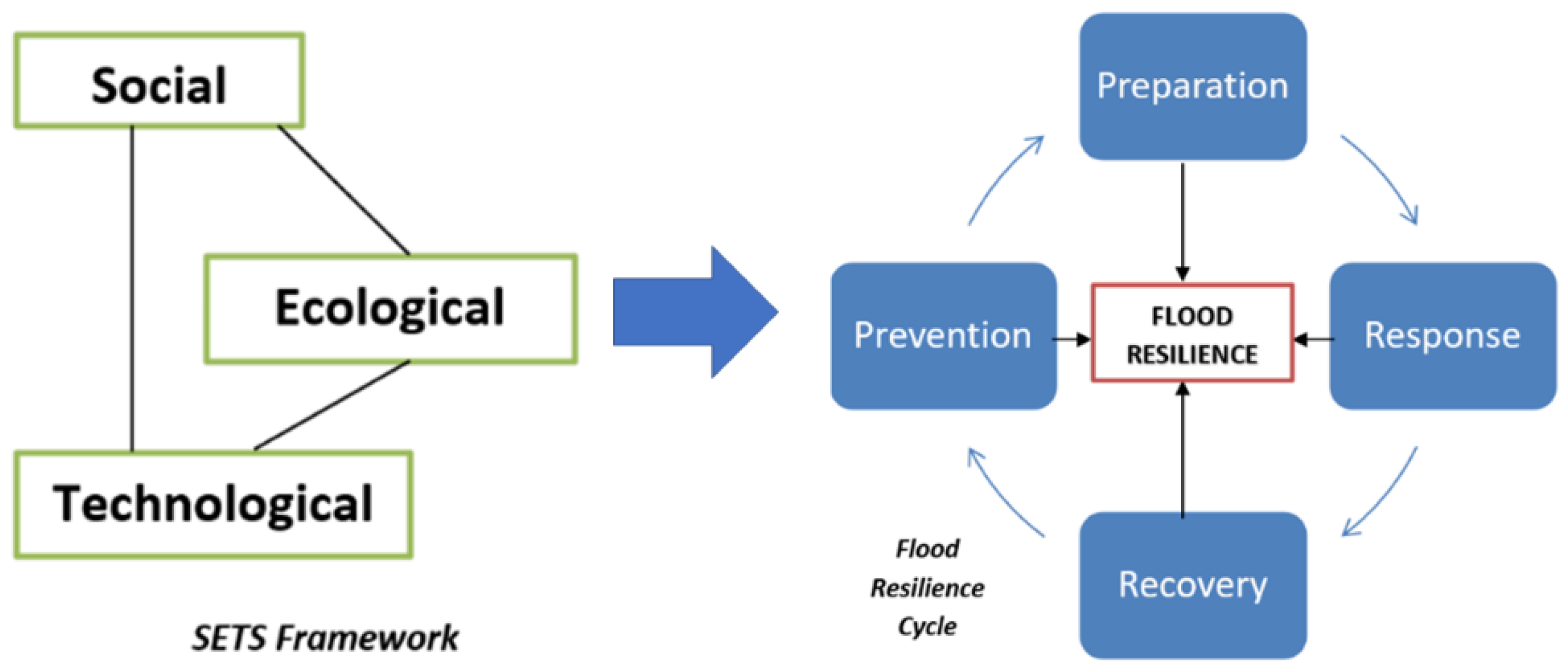
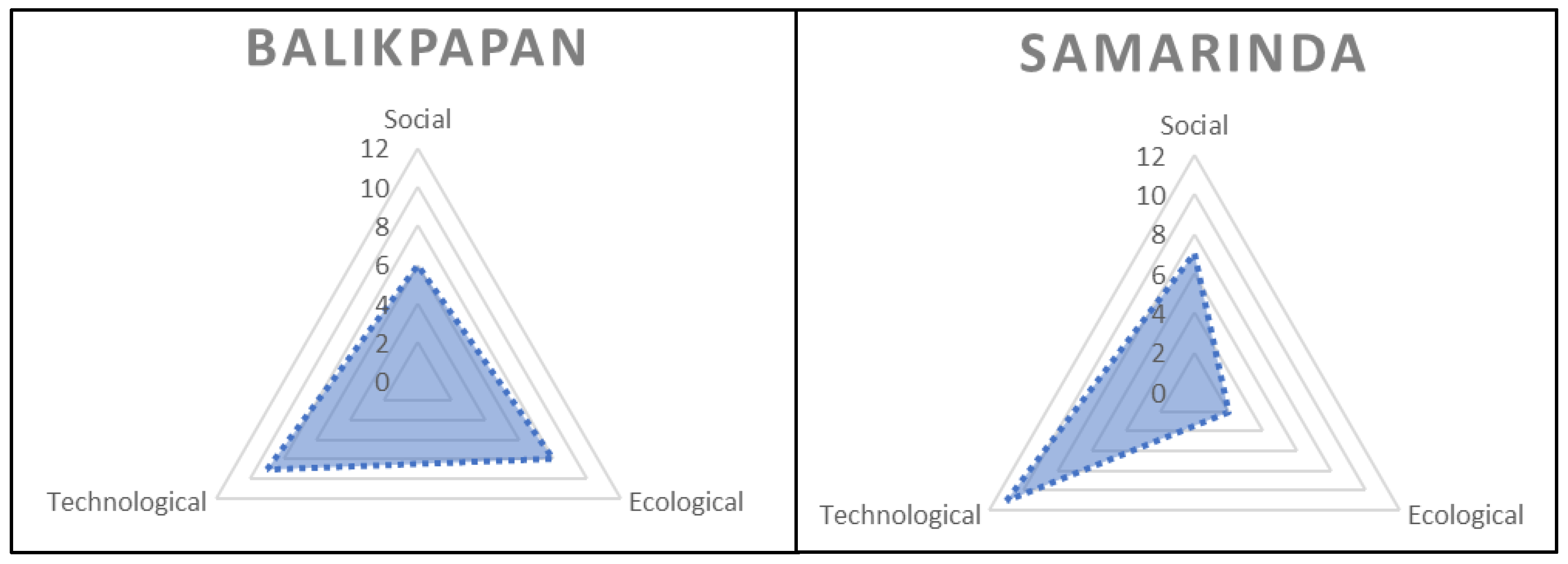
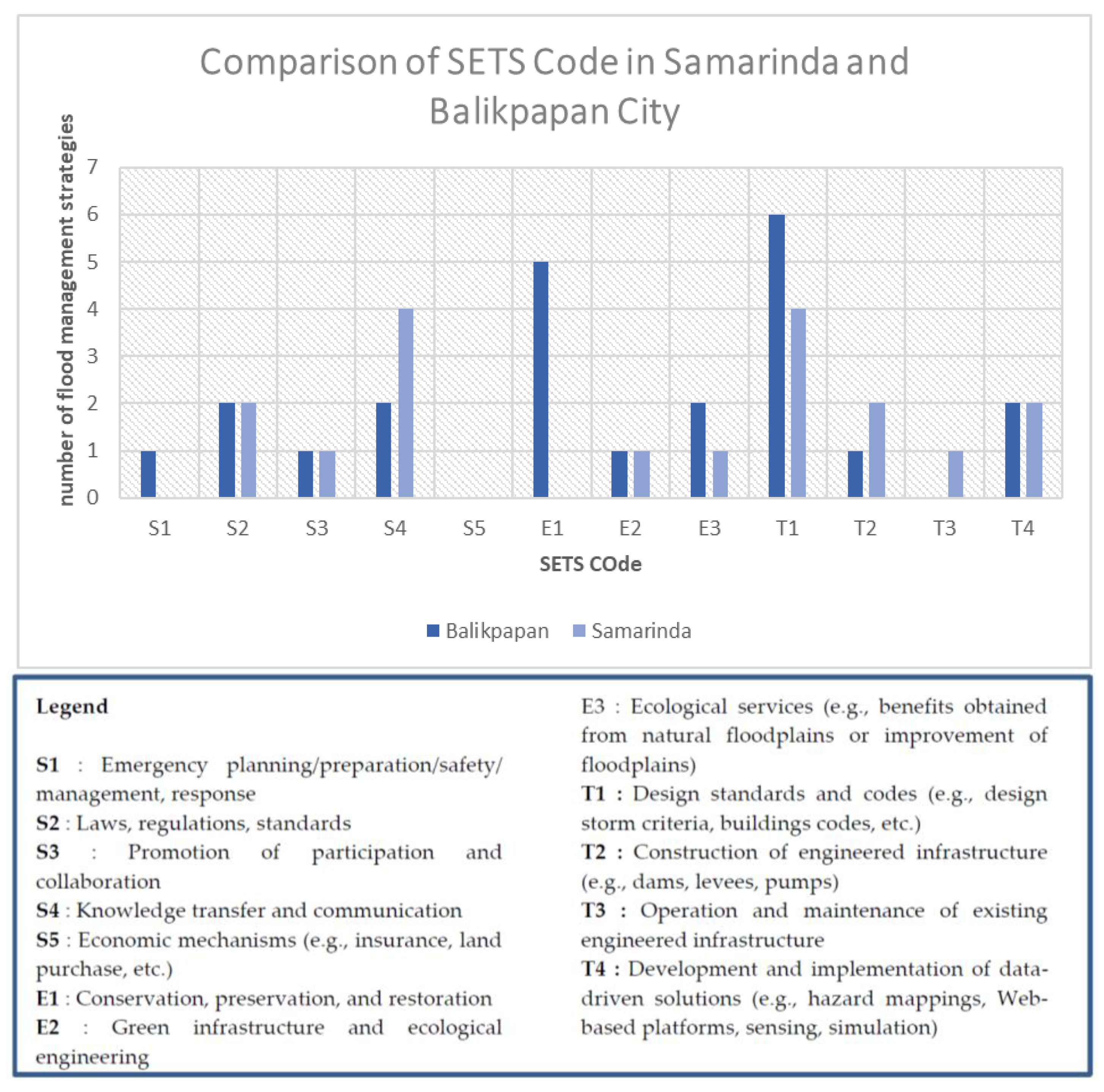
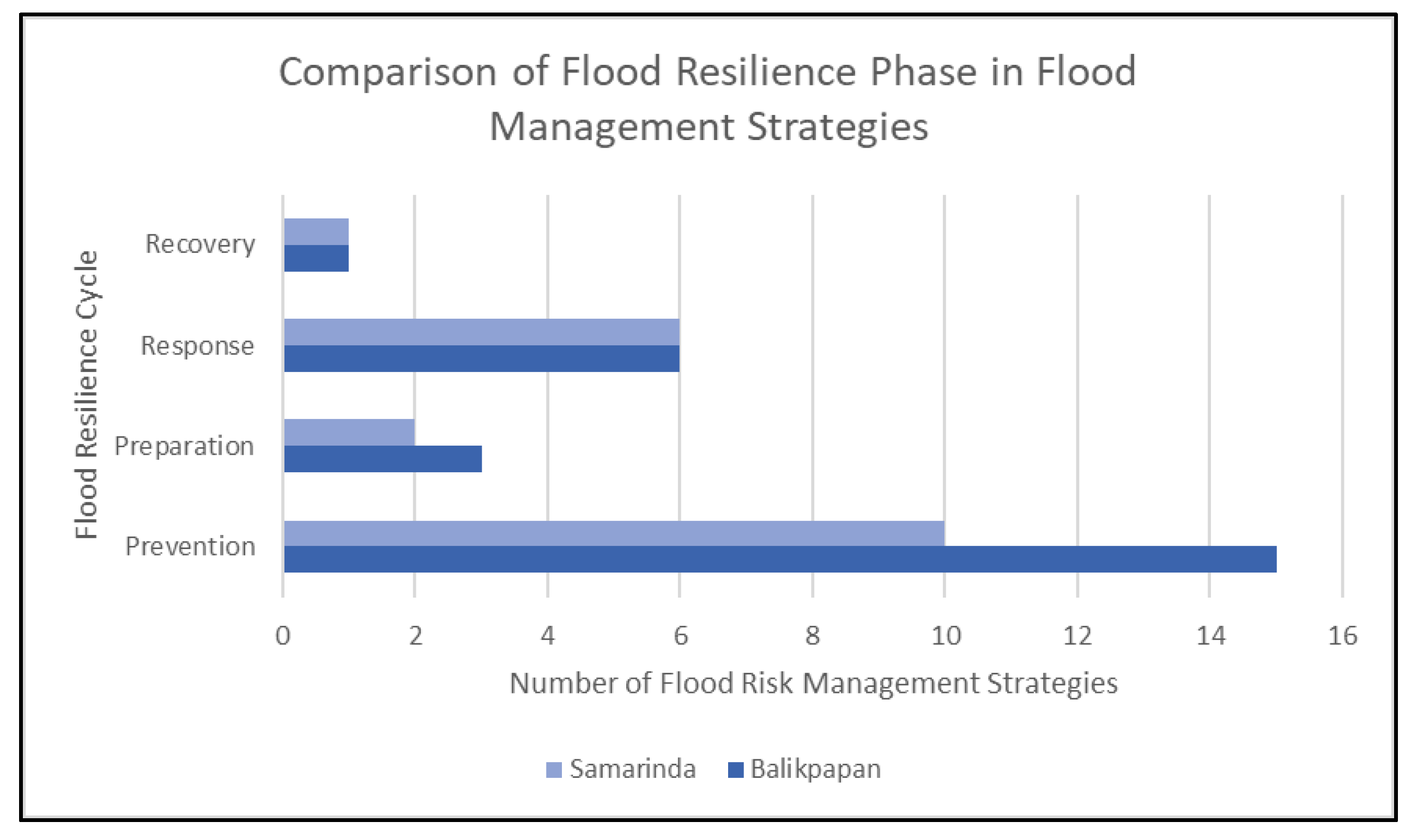

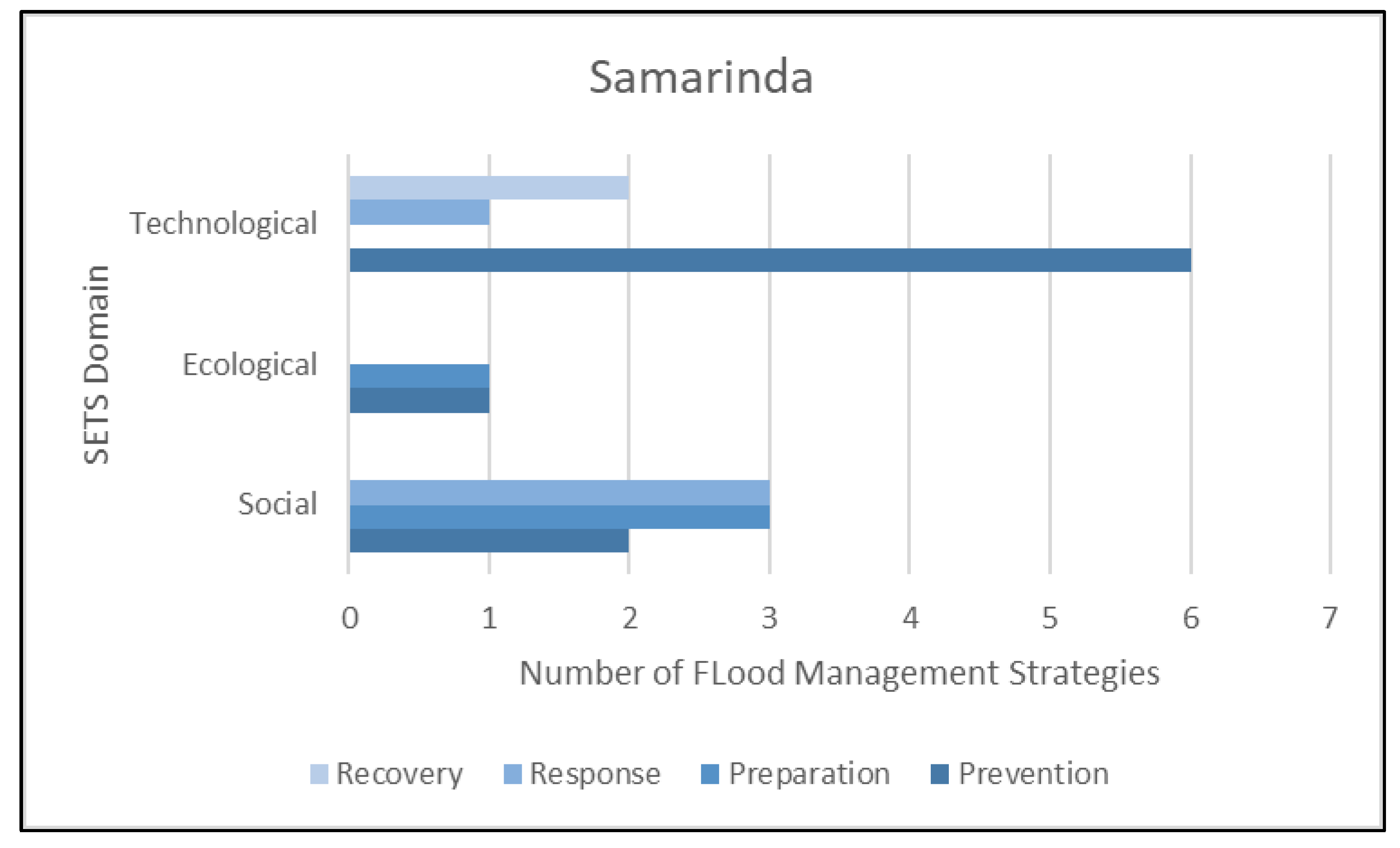
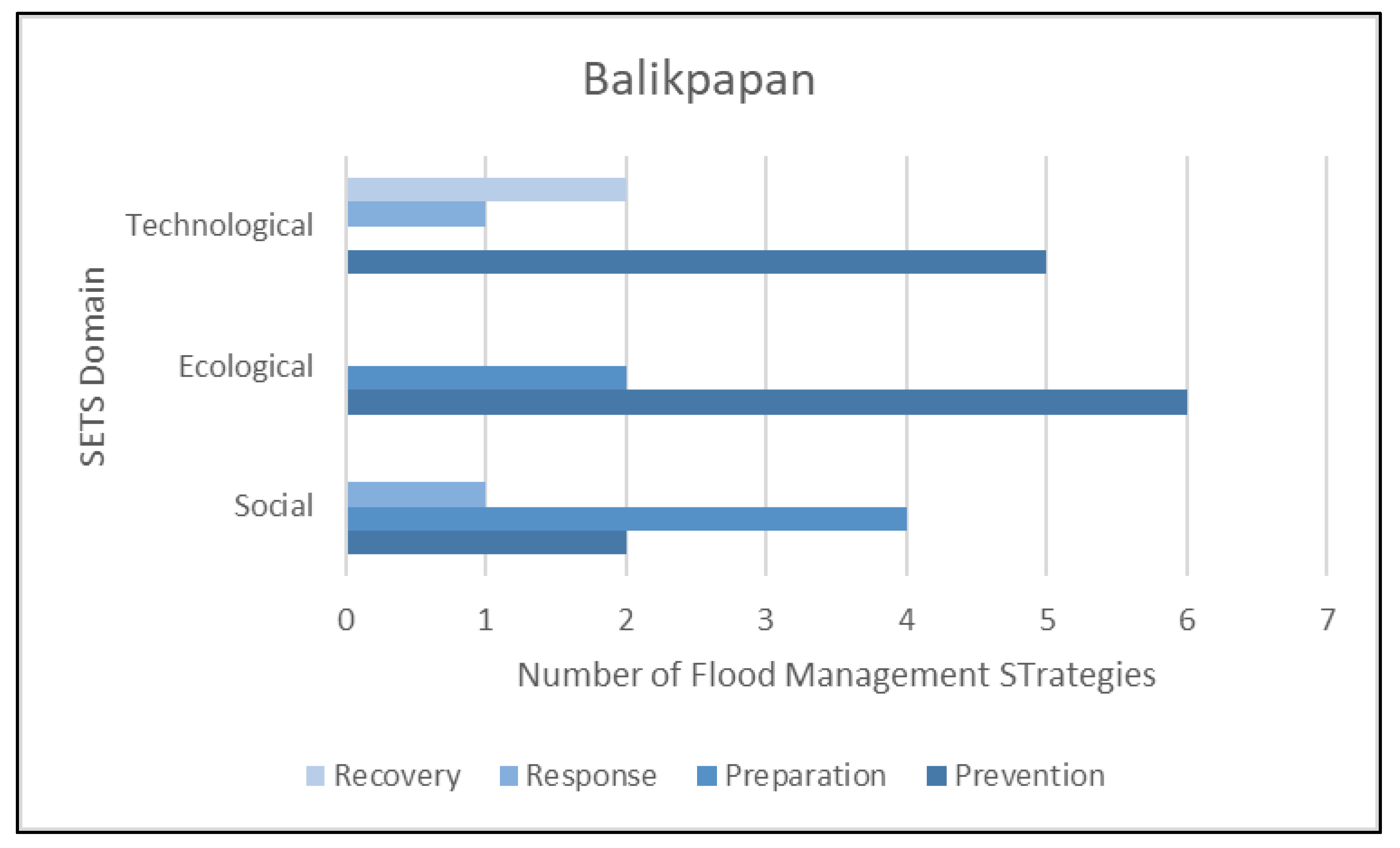
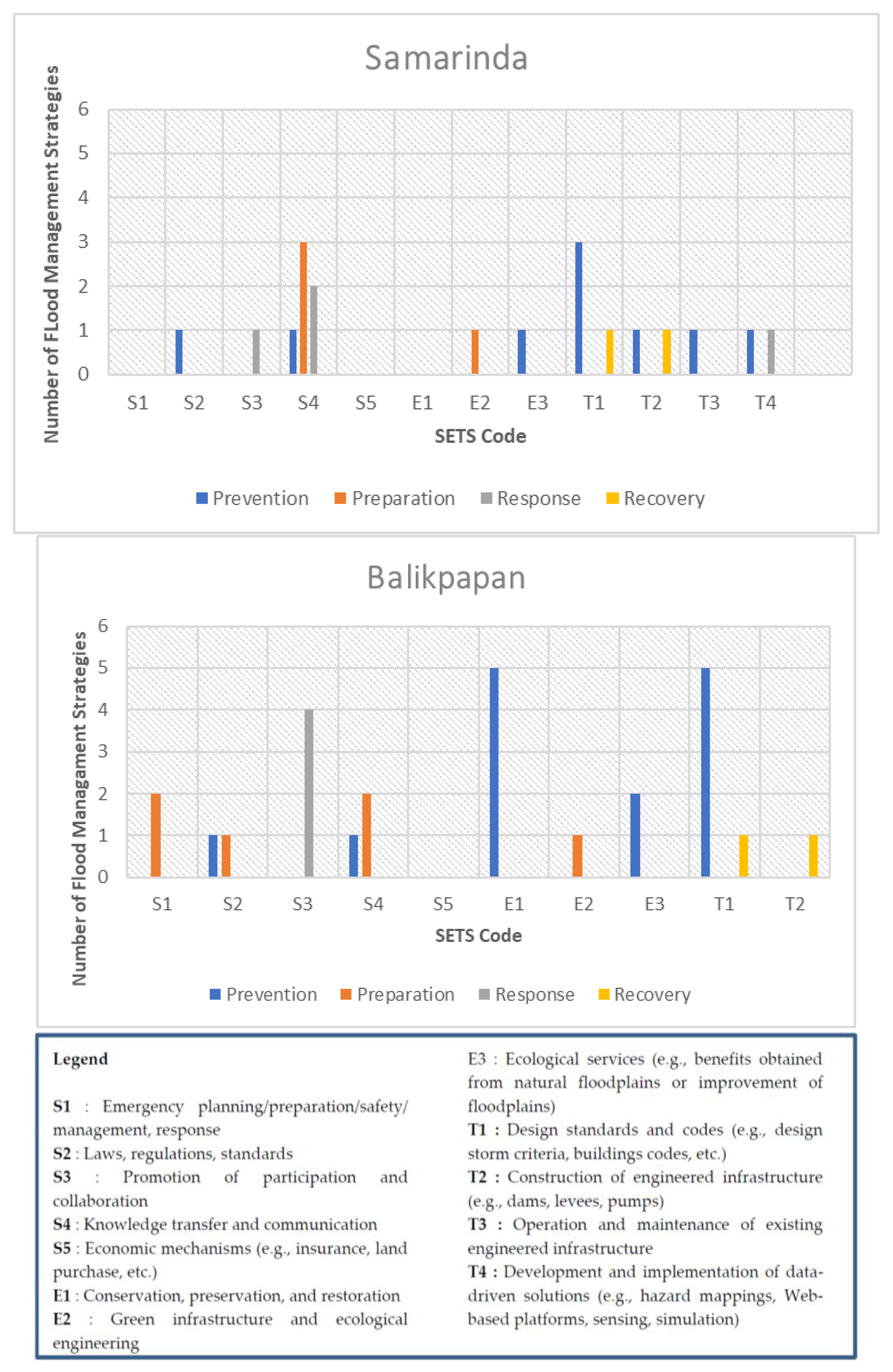

| SETS Domain | Category | SETS Code |
|---|---|---|
| Social | Emergency planning/preparation/safety/management, response | S1 |
| Laws, regulations, and standards | S2 | |
| Promotion of participation and collaboration | S3 | |
| Knowledge transfer and communication | S4 | |
| Economic mechanisms (e.g., insurance and land purchase) | S5 | |
| Ecological | Conservation, preservation, and restoration | E1 |
| Green infrastructure and ecological engineering | E2 | |
| Ecological services (e.g., benefits obtained from natural floodplains or improvement of floodplains) | E3 | |
| Technological | Design standards and codes (e.g., design storm criteria and buildings codes) | T1 |
| Construction of engineered infrastructure (e.g., dams, levees, and pumps) | T2 | |
| Operation and maintenance of existing engineered infrastructure | T3 | |
| Development and implementation of data-driven solutions (e.g., hazard Mappings, Web-based platforms, sensing, and simulation) | T4 |
| Aspects | Balikpapan | Samarinda |
|---|---|---|
| Temperature (average) | 31 degrees Celsius | 33 degrees Celsius |
| Population | 688,318 people | 827,994 people |
| Flood events (2021) | 30 | 66 |
| Area | 503.3 km² | 717.4 km² |
| Major cause of flood | Heavy precipitation | Heavy precipitation |
| Topography | Coastal city, 85% of the area is hilly | Topography of lowlands crossed by rivers |
| Aspects | Balikpapan | Samarinda |
|---|---|---|
| Smart Living |
| Early Warning System Development for Flood Risk |
| Smart Branding |
| Implementing waterfront city concept by building infrastructures to face the flood problem |
| Smart Environment | Developing Strategies for Supporting Sustainable Development Goals in Balikpapan | Development of drainage systems and riverbank management |
| Smart Society | Enhancing community capacity for adapting to disaster | Socializing utilization of Early Warning System for Local Community |
Publisher’s Note: MDPI stays neutral with regard to jurisdictional claims in published maps and institutional affiliations. |
© 2022 by the authors. Licensee MDPI, Basel, Switzerland. This article is an open access article distributed under the terms and conditions of the Creative Commons Attribution (CC BY) license (https://creativecommons.org/licenses/by/4.0/).
Share and Cite
Ariyaningsih; Shaw, R. Integration of SETS (Social–Ecological–Technological Systems) Framework and Flood Resilience Cycle for Smart Flood Risk Management. Smart Cities 2022, 5, 1312-1335. https://doi.org/10.3390/smartcities5040067
Ariyaningsih, Shaw R. Integration of SETS (Social–Ecological–Technological Systems) Framework and Flood Resilience Cycle for Smart Flood Risk Management. Smart Cities. 2022; 5(4):1312-1335. https://doi.org/10.3390/smartcities5040067
Chicago/Turabian StyleAriyaningsih, and Rajib Shaw. 2022. "Integration of SETS (Social–Ecological–Technological Systems) Framework and Flood Resilience Cycle for Smart Flood Risk Management" Smart Cities 5, no. 4: 1312-1335. https://doi.org/10.3390/smartcities5040067
APA StyleAriyaningsih, & Shaw, R. (2022). Integration of SETS (Social–Ecological–Technological Systems) Framework and Flood Resilience Cycle for Smart Flood Risk Management. Smart Cities, 5(4), 1312-1335. https://doi.org/10.3390/smartcities5040067









